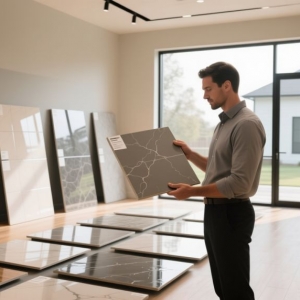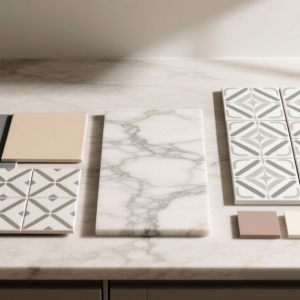Europe has always been a trendsetter in the world of tile design, influencing styles and materials that find their way into homes across the globe. From the intricate mosaics of the Mediterranean to the sleek, minimalist designs of Scandinavia, European designers are constantly pushing the boundaries of what's possible with tile. These trends are not just about aesthetics; they also offer practical insights into how to balance style with functionality. Whether you're planning a kitchen renovation or a bathroom update, understanding these trends can help you make informed choices that will stand the test of time. This guide explores the major directions in European tile design and provides practical tips for incorporating them into your home.
Why European Tile Trends Matter Right Now
European manufacturers are renowned for their dedication to design and precision. They invest in state-of-the-art production technologies that ensure fine finishes and consistent sizing. This results in tiles that look intentional and install seamlessly. Many of these collections are available in both luxury tiles and more affordable options, offering a wide range of choices without compromising on style. Whether you're on a budget or splurging on high-end materials, European trends provide inspiration for every price point.
Classic Looks That Keep Coming Back
Some tile designs have stood the test of time. Terrazzo, encaustic-style patterns, subway tiles, and hexagons are timeless choices that add warmth and personality to any space. These classic motifs are versatile and durable, making them ideal for high-traffic areas. Terrazzo tiles, for instance, are excellent for floors as they hide dirt effectively. Subway tiles on a backsplash are both timeless and easy to clean. If you're looking for a design that won't go out of style, classic European motifs are a safe and stylish bet.
Big Slabs and Large-Format Tiles: The Contemporary Baseline
Contemporary European design embraces large-format tiles and big porcelain slabs. These tiles mimic natural materials like marble, limestone, and concrete, creating a seamless, continuous surface with minimal grout lines. This minimalist look is particularly effective in open-plan homes and modern bathrooms, making small rooms appear larger. However, large-format tiles require a flat substrate and careful installation to achieve the desired effect. If you opt for luxury tiles in large formats, be prepared to invest in precise tiling and a skilled professional.
Texture Is Back — Subtly and Strategically
Smooth, glossy finishes are no longer the only option. Textured finishes are making a comeback, adding depth and tactility to spaces. Honed stone, brushed porcelain, and low-relief geometric tiles offer subtle patterns that enhance the overall design without overwhelming it. Texture interacts with light, creating a dynamic visual effect. Use textured tiles strategically as accents, such as on a shower wall, behind a stove, or in a hallway. Too much texture can feel heavy, so it's essential to use it sparingly.
Colour Trends: Muted Bases and Jewel Accents
European palettes have shifted towards softer, more muted tones. Warm greys, clay hues, and off-whites form the neutral foundation for many collections. Designers then introduce deeper, jewel tones like forest green, navy, or rich terracotta to add drama and visual interest. These bold colours work best in small doses, such as on a niche, backsplash, or feature floor. If you're unsure about the colour scheme, take samples from the tile shop and view them in your home. Lighting can dramatically affect the appearance of colours, so it's crucial to test them in different light conditions.
Pattern Mixing — Restraint and Intentionality
Pattern mixing is a common feature in European design, but it's done with restraint. The key is to choose one dominant pattern and one supporting pattern. For example, a bold patterned floor can be paired with calm walls, or a small patterned band can highlight a vanity. Scale is also important; small patterns work as texture, while large patterns function as graphics. Keeping the colour palette limited ensures that the mix feels cohesive and intentional.
Technology and Buildability: Thin Slabs, Rectified Edges
Advancements in manufacturing have revolutionized the use of tiles. Thin porcelain slabs can now be used for cladding, countertops, and furniture faces, offering versatile design options. Rectified edges allow for narrow joints, creating a seamless look. These technological advancements make European styles more adaptable, but they also increase installation demands. Proper adhesives and movement joints are essential for the longevity of thin slabs. When purchasing luxury tiles or large-format pieces, consult with your tiler about the recommended installation methods.
Sustainability: Recycled and Low-Energy Options
Sustainability is increasingly important in European tile design. Many collections now include recycled content and are produced using lower-energy methods. Recycled glass mosaics and porcelain with recycled aggregates are becoming more common. Some manufacturers even publish environmental data. If sustainability is a priority, ask the tile shop for certificates and Environmental Product Declarations (EPDs). Often, the greenest choice is a durable tile that lasts for decades, reducing waste over time.
How to Use Luxury Tiles Without Overspending
Luxury tiles can elevate a room, but they don't have to cover every surface. Use premium slabs strategically on key surfaces, such as living room floors, bathroom walls, or kitchen island faces. Fill secondary areas with quality porcelain that mimics the look of luxury tiles. This approach gives the appearance of luxury while keeping costs manageable. Always compare samples and ask the tile shop for alternative lines that match the desired aesthetic.
Practical Choices: Grout, Layout, and Lighting
Don't overlook the small details, as they can significantly impact the overall look and feel of your space. Grout colour, for instance, can shift the entire aesthetic. Matching grout creates a seamless look for large slabs, while contrasting grout highlights geometry and pattern. Tile orientation also matters; laying long planks lengthwise can visually expand a narrow room. Finally, test tiles in your home's lighting. Bring samples home and observe them in both morning and evening light to avoid any surprises.
Maintenance and Long-Term Thinking
Consider the maintenance requirements of your chosen tiles. Natural stone and certain textured finishes may need sealing and regular care, while glazed porcelain is low maintenance. Think about your lifestyle and how you use your space. Factors like children, pets, heavy cooking, and humidity can influence your choice. Durability and ease of cleaning are just as important as aesthetics. A tile that looks beautiful but requires constant upkeep may not feel luxurious in daily life.
Final Thought: Make Trends Work for Your Life
European tile trends offer a wealth of options, from classic patterns to large slabs, textures, and subtle colourways. Use these trends as tools to create a space that reflects your style and meets your practical needs. Visit a tile shop, handle samples, and discuss installation requirements with your tiler. When trend and practicality align, your space will feel curated and enduring, rather than merely fashionable.











